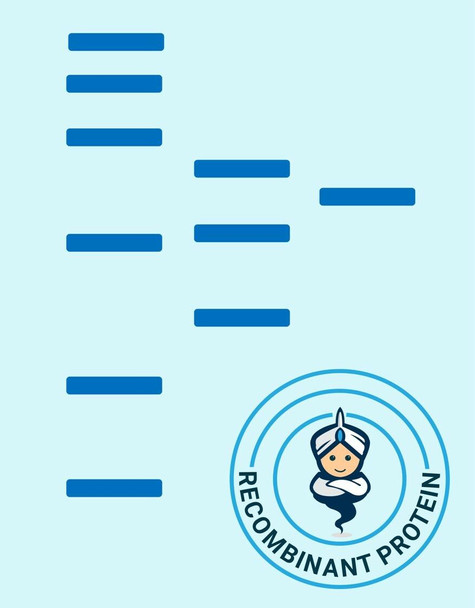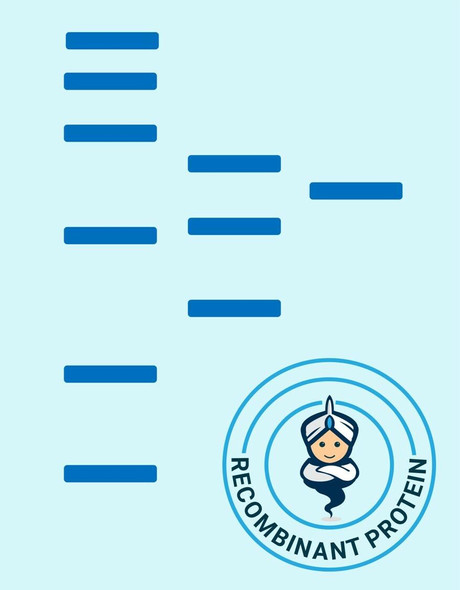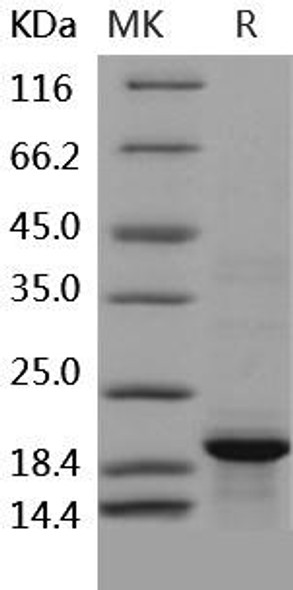Cytokines Recombinant Proteins
Human BAFF Recombinant Protein (RPPB0084)
- SKU:
- RPPB0084
- Product Type:
- Recombinant Protein
- Species:
- Human
- Uniprot:
- Q9Y275
- Research Area:
- Cytokines
Description
| Product Name: | Human BAFF Recombinant Protein |
| Product Code: | RPPB0084 |
| Size: | 20µg |
| Species: | Human |
| Target: | BAFF |
| Synonyms: | BAFF, BLYS, CD257, TALL1, THANK, ZTNF4, TALL-1, TNFSF20, TNFSF13B, B-cell Activating Factor. |
| Source: | Escherichia Coli |
| Physical Appearance: | Sterile Filtered White lyophilized (freeze-dried) powder. |
| Formulation: | Lyophilized from a 0.2�m filtered concentrated solution in PBS, pH 7.0. |
| Solubility: | It is recommended to reconstitute the lyophilized BAFF in sterile 18M-cm H2O not less than 100�g/ml, which can then be further diluted to other aqueous solutions. |
| Stability: | Lyophilized BAFF although stable at room temperature for 3 weeks, should be stored desiccated below -18°C. Upon reconstitution BAFF should be stored at 4°C between 2-7 days and for future use below -18°C.Please prevent freeze-thaw cycles. |
| Purity: | Greater than 95.0% as determined by:(a) Analysis by RP-HPLC.(b) Analysis by SDS-PAGE. |
| Amino Acid Sequence: | MAVQGPEETV TQDCLQLIAD SETPTIQKGS YTFVPWLLSF KRGSALEEKE NKILVKETGY FFIYGQVLYT DKTYAMGHLI QRKKVHVFGD ELSLVTLFRC IQNMPETLPN NSCYSAGIAK LEEGDELQLA IPRENAQISL DGDVTFFGAL KLL |
| Biological Activity: | The activity is determined by a mouse splenocyte survival assay. The ED50 for this effect is 0.5-2.0�g/ml. |
BAFF binds to tnfrsf13b/taci and tnfrsf17/bcma. Tnfsf13/april binds to the same 2 receptors, together, they form a 2 ligands -2 receptors pathway involved in the stimulation of b- and t-cell function and the regulation of humoral immunity.�A third b-cell specific baff-receptor (baffr/br3) promotes the survival of mature b-cells and the b-cell response.B Lymphocyte Stimulator functions as a potent B-cell growth factor in costimulation assays. Administration of BAFF Human recombinant to mice disrupts splenic B-cell and T-cell zones and results in elevated levels of serum immunoglobulin.
BAFF Human Recombinant produced in E.Coli is a single, non-glycosylated polypeptide chain containing 153 amino acids and having a molecular mass of 17007 Dalton. The BAFF is purified by proprietary chromatographic techniques.
| UniProt Protein Function: | BAFF: Cytokine that binds to TNFRSF13B/TACI and TNFRSF17/BCMA. TNFSF13/APRIL binds to the same 2 receptors. Together, they form a 2 ligands -2 receptors pathway involved in the stimulation of B- and T-cell function and the regulation of humoral immunity. A third B-cell specific BAFF-receptor (BAFFR/BR3) promotes the survival of mature B-cells and the B-cell response. Belongs to the tumor necrosis factor family. 2 isoforms of the human protein are produced by alternative splicing. |
| UniProt Protein Details: | Protein type:Apoptosis; Membrane protein, integral; Cytokine; Cell cycle regulation Chromosomal Location of Human Ortholog: 13q32-q34 Cellular Component: extracellular space; perinuclear region of cytoplasm; cytoplasm; plasma membrane; integral to membrane Molecular Function:protein binding; cytokine activity; tumor necrosis factor receptor binding; receptor binding Biological Process: cell proliferation; B cell costimulation; B cell homeostasis; immunoglobulin secretion; T cell costimulation; positive regulation of cell proliferation; positive regulation of germinal center formation; positive regulation of B cell proliferation; immune response; positive regulation of T cell proliferation; signal transduction |
| NCBI Summary: | The protein encoded by this gene is a cytokine that belongs to the tumor necrosis factor (TNF) ligand family. This cytokine is a ligand for receptors TNFRSF13B/TACI, TNFRSF17/BCMA, and TNFRSF13C/BAFFR. This cytokine is expressed in B cell lineage cells, and acts as a potent B cell activator. It has been also shown to play an important role in the proliferation and differentiation of B cells. Alternatively spliced transcript variants encoding distinct isoforms have been identified. [provided by RefSeq, Mar 2011] |
| UniProt Code: | Q9Y275 |
| NCBI GenInfo Identifier: | 13124573 |
| NCBI Gene ID: | 10673 |
| NCBI Accession: | Q9Y275.1 |
| UniProt Secondary Accession: | Q9Y275,Q6FHD6, Q7Z5J2, E0ADT7, |
| UniProt Related Accession: | Q9Y275 |
| Molecular Weight: | 17,578 Da |
| NCBI Full Name: | Tumor necrosis factor ligand superfamily member 13B |
| NCBI Synonym Full Names: | tumor necrosis factor (ligand) superfamily, member 13b |
| NCBI Official Symbol: | TNFSF13B�� |
| NCBI Official Synonym Symbols: | DTL; BAFF; BLYS; CD257; TALL1; THANK; ZTNF4; TALL-1; TNFSF20�� |
| NCBI Protein Information: | tumor necrosis factor ligand superfamily member 13B; delta BAFF; Delta4 BAFF; B-lymphocyte stimulator; B-cell-activating factor; ApoL related ligand TALL-1; TNF homolog that activates apoptosis; dendritic cell-derived TNF-like molecule; tumor necrosis factor-like protein ZTNF4; TNF and ApoL-related leukocyte expressed ligand 1; tumor necrosis factor (ligand) superfamily, member 20 |
| UniProt Protein Name: | Tumor necrosis factor ligand superfamily member 13B |
| UniProt Synonym Protein Names: | B lymphocyte stimulator; BLyS; B-cell-activating factor; BAFF; Dendritic cell-derived TNF-like molecule; TNF- and APOL-related leukocyte expressed ligand 1; TALL-1; CD_antigen: CD257Cleaved into the following 2 chains:Tumor necrosis factor ligand superfamily member 13b, membrane form; Tumor necrosis factor ligand superfamily member 13b, soluble form |
| UniProt Gene Name: | TNFSF13B�� |
| UniProt Entry Name: | TN13B_HUMAN |






